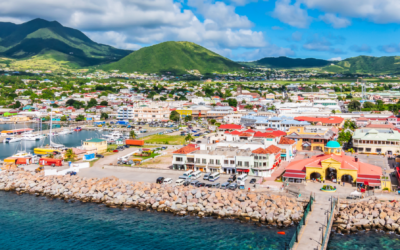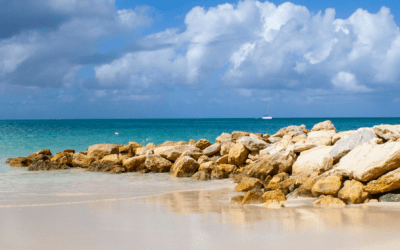Dateline: New Delhi, India Today I want to talk about one of the challenges people face when they get a new passport. One of the first questions that new passport holders face is “Should I use it?”, “How do I use it?” and “What’s going to happen?” Even I fall into this trap where you worry about using your new passport. And when you are a new citizen of the Comoros Islands, you obviously can’t go to a lot of places with your plan B passport without having to really think about what’s possible and what’s not. I have a passport from the Comoros Islands, so I am learning to what extent I can use it. As I mentioned, there are some travel benefits. Even with the limited number of countries that don’t require a visa that I can visit with my new passport. The one big benefit is that it includes access to Asia. This is especially nice because there are numerous other middle tier passports that do not allow access without a visa to Asia.
Putting The Comoros Passport to The Test
To test this all out, though, I decided to make Malaysia my first example. Let’s see just how legitimate a Comoros passport actually was. So I got on a plane to Malaysia. I was flying from Egypt where I couldn’t use the Comoros passport, so I left as a US citizen. After which I flew through Doha and when I checked in for the next flight I showed them the Comoros passport to go to Malaysia. The guy barely even looked at it. This seemed like a good sign, but it almost seemed a little bit too good to be true. More often than not, they ask for your passport 17 times and they get on your case. It was almost a little bit eerie that they didn’t ask me any questions this time. The guy in Doha seemed to not care. Maybe he knew that Malaysia is a pretty easy place to get into for people from most countries. Either way, I got to Malaysia and like I typically do, ran off to the passport line as quickly as possible. I presented my new passport to the woman at the immigration desk. She looked at it and said, “Okay, great. It’s a new passport. How long are you staying here?” I told her 16 days and she pulled out her little book and took a look at the guide because she didn’t even know the country. As she looked through the guide I said: “30 days, right?” And, sure enough, she found The Comoros Islands and I was good to stay in Malaysia for 30 days. She stamped my passport for the 30 days as usual and said: “Thank you, have a nice day”. And that was that.
New Passport’s Special Travel Benefits?
It’s interesting that as a US citizen you think that if you’re from out of the US, they won’t want you there with your plan B passport or it will be harder to get in. And perhaps things were so easy for me because — despite not knowing where my country is located — I look like someone from a reputable country. I say this because, quite frankly, in Asia, they look at certain people and judge your legitimacy based on looks. However, I don’t entirely believe that because someone from our team who needed a visa to enter Malaysia (but wasn’t aware that they just changed the rule) was denied entry. Even though she is white and blond, they didn’t let her in. So really, it comes down to the country. There are some stories out there though of people not being let into a certain country because of their new passport. For example the guy who flew to the UK with his Dominican new passport and said he invested to get it and got kicked out because he required a visa to access the country. I think that in general, immigration officers are just there to follow the rules. In my nominal experience over the last years, if it says Comoros gets 30 days, they give your Comoros passport access for 30 days.
Play By The New Passport Rules
Now, what I think is not a bad strategy to have, if you’re coming as a Comorian and not as an American, is to check the requirements and see whether you are required to show proof of funds or meet some other requirement in order to gain entrance with your plan B passport. Some countries require you to show $50 a day in cash, a valid credit card or your hotel reservation. If, as an American, you’re used to just waltzing right in, you may find it helpful to have your hotel reservation and return ticket printed out as a new passport holder of a lesser-known country. Have some cash on you. Have the Amex platinum card ready to show. Dress nicely. I’m working this out myself with the different approaches, but there is a spirit of the law that is often not followed for folks from the West that might apply to you now holding a new passport. Quite frankly, based on my experience up to this point, they’re just going to follow the letter of the law. So don’t freak out and think you have special privileges that you’re losing when carrying a plan B passport. If you get in, you get in.
The Comoros Passport Visa-free Access to Indonesia
Next stop: Indonesia. Now, supposedly, the Comoros passport should have visa-free entrance into Indonesia. In fact, on the flight there I saw an ad in an in-flight magazine advertising the recent change allowing 169 countries to gain access to Indonesia without a visa. Just a couple of months ago most people had to pay $40 on arrival. A while back they began to open up to places like Germany and Australia. Now they’ve opened up to just about everyone — the Comoros Islands included. Perhaps it is because it is a recent change, or maybe because the The Comoros Islands are not well known, but when I came into Indonesia and presented my Comoros passport the immigration officer said, “No, no, no… we do not accept…” As he started to say no I said, “Well, I have this passport, too,” and I showed him my US passport. He replied much more warmly and said, “Yeah, yeah, let’s just do that passport. There’s no fee.” According to the books, the Comoros passport shouldn’t have a fee either. But here’s the challenge with having visa-free access on a passport that isn’t as particularly “popular” as mine. If the guy at the immigration desk doesn’t know, you’re likely out of luck. If it doesn’t work in practice then it doesn’t matter what the law is in theory. I told the guy that I was happy to pay the $25 because I’m trying to use my Comoros passport. But I eventually gave up because I just really didn’t want to bother with it. Especially after one of my team members got held in an immigration jail last week after a visa misunderstanding. I didn’t want to cause any problems, so I simply handed over my US passport and entered the country.
The Plan B Passport Challenge
But this situation brings up a lot of questions. There is an inherent issue in traveling to a country where your passport is not commonly seen. If you’re not amongst the countries like the United States, Australia, Germany, or others that are well-known pretty much anywhere you go, you may be met with some confusion. If your passport is not commonly seen there, then maybe they’re going to look, maybe they don’t know, maybe they’ll ask the guy next to them and it’s going to be a little bit of a pain. Of course, you can deal with the confusion and educate the immigration officials, but that’s something to think about. And this is an issue for passport holders from a lot of economic citizenship countries. Unless you’re going to spend the big money for Malta or Cyprus, people won’t know much about Dominica. They’re going to have to look it up and, in the case of Malaysia, say “Okay, the book says this”. Or they might just say, like the Indonesian guy who was very nice but didn’t seem that authoritative, “No, no, no, better to use this one.” How long would it have taken if I only would have had the Comoros passport? Who knows? So it’s important to be prepared in that regard and that’s kind of an important note when you’re getting any economic citizenship that’s at a reasonable price.
The Ultimate Plan B Passport
But beyond those issues, let’s take a look at the list of countries you actually have visa-free access to (at least on paper) with a Comoros passport. To be honest, the options are pretty limited. Because of that, Comorian citizenship by investment is obviously the cheapest program available. At $45,000 plus fees, it’s less than half the price of Dominica and St. Lucia. As we’ve talked about before, Comoros is really a Plan B passport. It’s not something you’re going to renounce your citizenship on, but it’s nice to use for different reasons. Especially if you want to use the Comoros passport as the ultimate backup. It would be especially useful if used as part of my belt and suspenders strategy we’ve discussed here before. If you’re really desperate and really hard up and don’t have a lot of money and you’ve got to renounce, you can always get it as a travel document and then pair it with a residence that will give you better travel options.
The Practicality of My Comoros Passport
What I like about the Comoros passport is that it can actually do a decent job of filling in the gaps of other plan B passports — especially in Southeast Asia. I’m a big fan of Eastern Europe now, and I’m increasingly looking at residency and citizenship programs in the region. In general, Eastern Europe has great travel around the rest of Europe. For example, my team members from Montenegro and Serbia can go all around Europe except for the UK and Ireland. They can also go to a number of places in South America. Where they can’t go in Mexico and Central America and a decent amount of Southeast Asia. In the Balkans in particular, the past wars caused some issues with countries in Southeast Asia. Which may explain why they still don’t have visa-free access here. But the bottom line is, if you’re looking at various countries in Eastern Europe (or any kind of country really), their best visa-free access is to their own region. This often applies among countries of a similar religion as well, for example, Islam. Having this in mind, a different belt and suspenders strategy would be to have an Eastern European passport that allows you to go to all the touristy places in South America and Europe. For instance, Georgians can go to most of South America, even places like Brazil where Americans can’t go. And they will soon have visa-free access to most places in Europe. Other Eastern Europeans — including those in the Balkan region — can already go to the Schengen Area. So if you take a passport like that from Eastern Europe and pair it up with the Comoros passport, the Comoros passport actually does very well.
Visa-free Access with a Comoros Passport
But where exactly can you go? Of course, the Comoros passport includes visa-free access to parts of Africa. Every passport has their own different visa-free access to countries in Africa — it’s a very hit and miss type of region when it comes to which countries you can get into. Most of the African countries, however, don’t look that appealing. You don’t get South Africa, Morocco, or Egypt, for example. If you did, I would have used my plan B passport when I was in Egypt. But where Comoros does really well is filling in the gaps that a lot of European passports that are labeled in the “plan B passport” category from the western world don’t fill in, particularly in Southeast Asia. The most notable countries that Comorians can visit include:
- Hong Kong: You don’t get much time in HK. But the 14 days you have are enough to do your banking, set up your business, check on your operations, etc. And, quite frankly, while I love Hong Kong, 14 days a year is all I’d ever want to spend there anyway.
- Macau: Just as Americans, citizens of the Comoros Islands only have to pay for a visa on arrival in Macau. It’s not that much different. So, with your Comoros passport, you can take the ferry over from Hong Kong and gamble away.
- Malaysia: As I documented, the Comoros passport gets 30 days in Malaysia. This is the same amount of time that a lot of Eastern Europeans get. It’s certainly not the 90 days you get with other passports and I expect that visa runs are harder in Malaysia as a Comorian than as an American or German or whatever, but you still get 30 days. That’s not so bad. And, again, in practice it’s worked for me.
- Indonesia: While you’re now supposed to get 30 days visa-free in Indonesia, note my experience. They claim you’re supposed to pay a visa on arrival fee, which I guess if I had just paid in advance I could have gone to the visa on arrival desk and paid it and then gone up to the immigration desk with my fee in hand. I imagine the immigration officer probably would have let me through with my Comoros passport in that case.
- Nepal: Visa on arrival.
- Ecuador: They let pretty much everyone in. Comorians get 90 days.
- Nicaragua: They give visas on arrival to a lot of different nationalities. This includes 90 days for a Comoros passport from the Comoros Islands.
- The Philippines: 30 days visa-free.
- Cambodia: Just like US passport holders, citizens of Comoros get a 30-day visa on arrival to Cambodia.
- Laos: As is the case for most everyone else, you’ll need to pay a $30 fee to receive a 30-day visa on arrival in Laos. I have my Cambodian e-visa issued, but you can also buy a visa once you’re there.
- India: While India allows $60 e-visas for Comorians just the same as they do for anyone else, India’s visa system is the worst system in the world.
- Panama: A generally friendly country to tourists, Panama gives Comoros passport holders a full 180 days in the country without a visa.
A Numbers Overview
These are the most notable countries on the Comoros Islands’ list of visa-free or visa-on-arrival countries. You don’t get some of the ones that are generally easy like Colombia and only get 47 countries in total. Compared to the best passport (Germany) which gives you visa-free access to 177 different countries, that’s not a whole lot. An average passport that can be used in most places you care about would give you access to about 130 countries. Passports in this category include countries like Serbia with access to 115 countries, Panama with access to 127, or Mexico with access to 139. So, with a Comoros passport, you are obviously well under that average. Still, there are a few beach countries that allow Comorians to come in simply because they allow most everyone in. Even Dominica allows Comorians visa-free access for 21 days. The Comoros passport would work if you wanted to constantly bounce around the world through countries that just had beaches. Like Malaysia, Indonesia, Hong Kong every once in a while, the Philippines, Cambodia, Laos, Panama, Dominica, Ecuador, etc. Southeast Asia is the region that is best covered, but you get some of Central and South America as well.
Challenges vs. Benefits of The Comoros Passport
The challenge with the Comoros passport is that it really is a second-tier Plan B passport. I think that visa runs are going to be difficult and you’re going to need a lot of transit passports. You can’t just fly through the UK, the US, or Canada without getting a visa. I’m not even sure about the EU. You’re not going to be able to fly through a lot of places. You’re going to need a visa just to fly through on your way. So if you’re flying from Malaysia to Ecuador, you’re going to fly through heaven-knows how many countries and you’re going to need transit visas for those. So it’s not the easiest passport to get around the world on. However, it’s one that — if you use it well enough — over time it could become a decent travel document. For instance, if you build up enough visas from Malaysia, Indonesia, Cambodia, Laos, and others and just kind of bummed around Southeast Asia for six months and got a lot of stamps, you might be able to go and apply for a visa to a place like Serbia or Mexico. If you can show them that you’ve gone to these six different countries and you came and went as prescribed and did nothing wrong, then maybe you can get to a Tier B country. Then after going to a couple of Mexico-level countries, you could apply for an EU visa. And after you get the EU visa then maybe you could apply for Canada or the US. I highly doubt you could go right to applying for a Canadian visa, though, especially if you’re doing an e-visa. So that’s the deal. 47 countries. Obviously, that’s not a lot. Still, the Comoros passport could make a good Plan B passport just to have in your back pocket. It’s going to be hard to travel all over the world, but it’s good for Southeast Asia. And it’s a great passport to pair with residency in the European Union or a passport from another country with complementary visa-free access to many other areas not on the Comoros list. Finally, it’s also a quick and cheap solution if you really need a passport to renounce. The key takeaway, however, is to remember that what happens, in reality, is much better than what happens on paper.
Why Having A “Bad Plan B Passport” Is Actually Good
“Where is your Kuwaiti visa?”, the agent at the airport check-in counter asked me. After a week in India, I’m headed to the tiny sultanate of Kuwait on a brief fact-finding mission of the Gulf state. So here I am, plunged into the chaos of Delhi’s busy airport being asked for proof that I’m legally able to enter the desert country. The question is not unreasonable. The queue for today’s flight appears to be made up almost entirely of Indian citizens who do need a visa. You could forgive the agent for being unfamiliar with Kuwait’s visa rules for westerners. I hand him a US passport and tell him to check for a visa on arrival status. “No, sir, you need a visa”, he insists. These discussions with airport personnel rarely end well, so I try a tactic most people prefer to simply be right: blind patriotism. “There wouldn’t be Kuwait if it weren’t for the United States”, I told him. “Please confirm it’s visa on arrival.” My sudden display of faith in my home country prompts the agent to check. And after a few punches on his keyboard, he confirms that, indeed, US citizens are eligible not only for visa-free access to their country on arrival but also for a waiver of the usual fee.
What Is A Plan B Passport Really for?
You might imagine that Kuwait’s friendly visa policy toward US citizens is partly a result of the first Gulf War in which the US military saved Kuwait from Saddam Hussein’s armies, and you might be right. Nevertheless, good relations between the two countries mean that I, unlike any of my counterparts in the queue, can show up in Kuwait City unannounced and without issue. For most people, including presumably most of the Indians waiting in line alongside me, that freedom to arrive in any number of countries without a visa is one of the most appealing benefits of a plan B passport. If your passport only allows travel to a limited number of places, it would be only natural to feel stuck… and to seek better travel options. Some western citizens – US citizens or otherwise – look for second citizenship as a “Plan B” against chaos, popularly known as a “plan B passport”. Allow me to suggest that such thinking might be ill-informed. There are two themes that I see in people I help get a plan B passport. The first is “I want it to be easy, and preferably fast”, indicating a desire for minimal effort. The second, the less common theme is, “I want it to be a good passport”. Thanks to our interpretation of a passport merely as a travel document, some westerners – who already have “good passports” – feel as if getting a plan B passport, or a “bad passport” would be beneath them. I find myself talking Americans out of the hassles of going to some country in the European Union and incurring a bunch of expenses in order to get what is essentially the same passport they have now… only five years from now, instead of getting a plan B passport with a decent set of visa-free travel options. If you plan to keep your current citizenship, not renounce it, then having a “good passport” is only a wise Plan B if your current passport is a “bad” plan B passport. That’s because travel freedom isn’t the only way to judge a plan B passport.
The Real Cost of Visa-free Travel
You see, US citizens are able to visit Kuwait visa-free. This is because the US government is a giant, global bureaucracy that sends billions of dollars in foreign aid overseas each year, fights wars around the world, and maintains embassies in every country on earth. All of these things cost a lot of money. Peru, for example, can’t afford to open 195 embassies in every sovereign country. Nor can it afford to rush to a country like Kuwait’s aid when a belligerent neighbor invades it. As a result, Peruvians cannot visit Kuwait, or a number of similar countries, without a visa. Externally, one might assume that a Peruvian passport as a plan B passport is of inferior quality to US passports. However, while US citizens are required to file numerous forms to report their foreign bank accounts and declare their worldwide income even while living abroad, Peruvians don’t have to. Nor did any Peruvian’s tax dollars go to fund an elective war in some faraway corner of the globe. Nor do Peruvian tax dollars fund embassies that resemble compounds and house cushy diplomats who live in five-star luxury on the government’s dime. And because Peru isn’t sticking its nose into every corner of the world, it has not set up mechanisms to track its citizens living overseas. Nor does it surveil their foreign phone calls. Nor are Peruvians viewed as imperious when they travel the world. The belief that passports offer excellent visa-free travel merely because the issuing country is rich is only true up until a point. Dozens of countries from Vietnam to Brazil don’t allow US citizens to visit without a visa, despite the fact that US tourism dollars could surely boost the economy. I imagine that Myanmar, India, Azerbaijan, Turkmenistan, or Venezuela could benefit from an influx of tourist cash. Yet they choose to make it difficult for US citizens – and in some cases all western citizens – to enter their country. So while a US passport offers good visa-free travel, that freedom comes at the price of a government that spends billions of dollars each year to buy influence. That influence buying also turns off other countries that in turn make entry difficult.
“Bad Plan B Passport” Is More Freedom
The point is this: a passport full of visa-free travel opportunities to a lot of countries can often be a double-edged sword. I have always been an advocate of smaller countries. Precisely because smaller countries don’t have expensive, burdensome infrastructures to maintain at your expense. Also, because small countries don’t follow you around the world tracking your every move and every dollar earned. Obtaining economic citizenship from Comoros fit nicely in my citizenship plans. Not because it allowed me to travel all over the world, but because it did not add to my personal regulatory burden. It feels nice to be a citizen of a country that leaves you alone. I’d argue that the average westerner – who likely has little experience in obtaining visas – overestimates the burden of getting visas. Obtaining a plan B passport that is fast and easy will likely require you to get a few visas for your future travel plans should you want to use it. After all, the only fast citizenship you can obtain that grants visa-free travel even to the United States is Malta. Malta requires you to fork over about $1 million. There is, however, the burden of obtaining visas, and then there is the burden of having to fund and be identified with being a citizen of the world’s (often unwelcome) policeman. You may find one burden to be easier to deal with, but they are both burdens. The benefit of economic citizenship is the ability to obtain a passport from a country that may not allow you to show up unannounced in Kuwait but certainly won’t subject you to its whims no matter where you go. And that can be very freeing.









